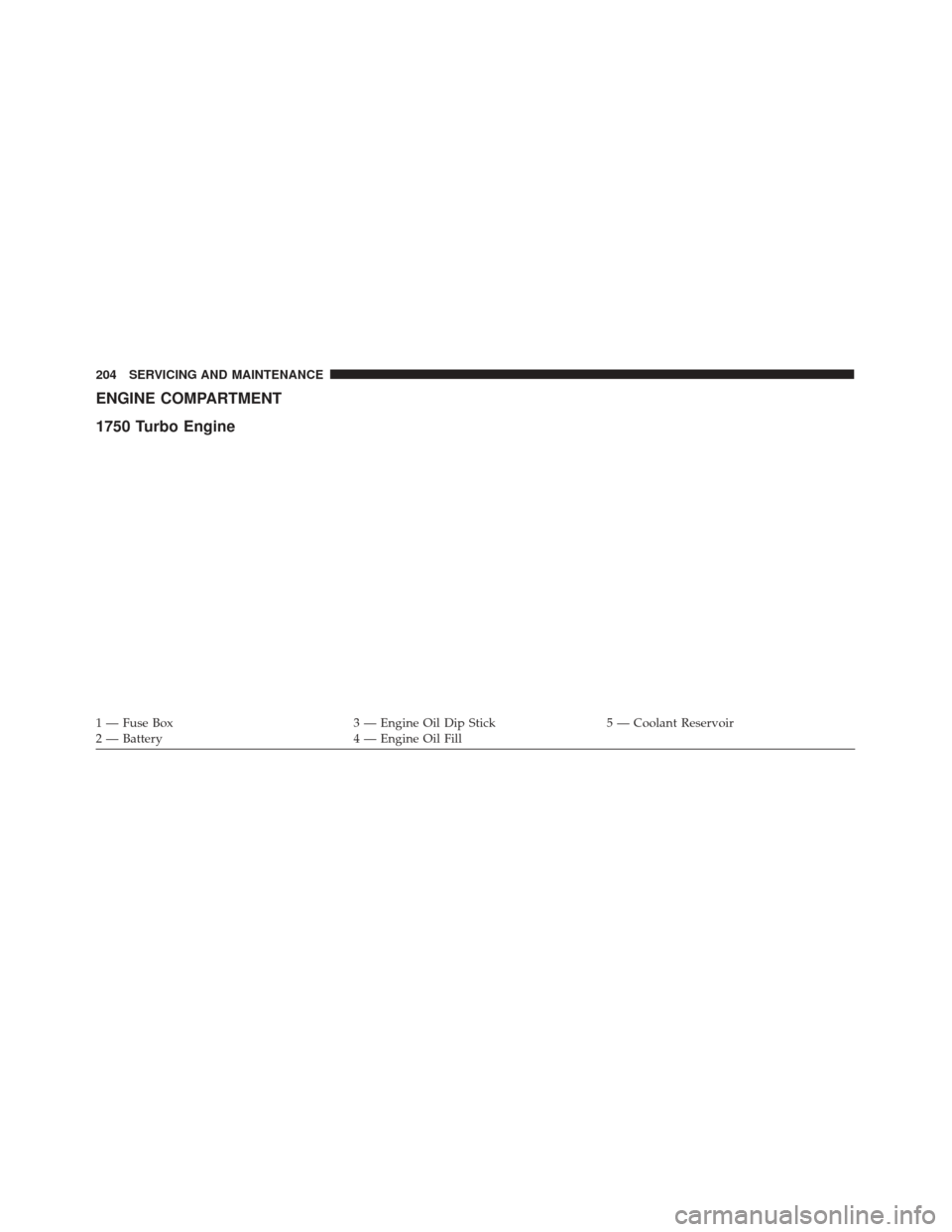fuse Alfa Romeo 4C Spider 2019 User Guide
[x] Cancel search | Manufacturer: ALFA ROMEO, Model Year: 2019, Model line: 4C Spider, Model: Alfa Romeo 4C Spider 2019Pages: 292, PDF Size: 3.25 MB
Page 183 of 292

CavityVehicle Fuse
Number Mini Fuse
Description
10 F51 7.5 Amp Brown Headlamp Washer Relay, A/C Compressor Relay,
High Beam Relay, Parking ECU, Vehicle Radio,
Stop Lamp Switch
11 F37 7.5 Amp Brown Stop Light Switch, Instrument Panel Node
12 F49 5 Amp Tan Transmission Shifter Module, Cigar Lighter Light,
Drive Style Unit, Heated Mirrors Relay, Parkview
System
13 F31 5 Amp Tan Climate Control, Body Controller
14 F47 20 Amp Yellow Driver Power Window
TIRE SERVICE KIT
Small punctures up to 1/4 inch (6 mm) in the tire tread
can be sealed with the Tire Service Kit. Foreign objects
(e.g., screws or nails) should not be removed from the
tire. Tire Service Kit can be used in outside tempera-
tures approximately from -40°F (-40°C) to 122°F (50°C).
This kit will provide a temporary tire seal, allowing you
to drive your vehicle up to a maximum speed of 50 mph
(80 km/h).
Tire Service Kit Storage Location
The Tire Service Kit is located in the rear storage area
under the decklid.
7
IN CASE OF EMERGENCY 181
Page 206 of 292

ENGINE COMPARTMENT
1750 Turbo Engine
1 — Fuse Box3 — Engine Oil Dip Stick5 — Coolant Reservoir
2 — Battery 4 — Engine Oil Fill
204 SERVICING AND MAINTENANCE
Page 281 of 292

Enhanced Accident Response Feature.......117,194
Ethanol .............................. .259
Euro Twin Clutch Transmission Fluid Type .......................... .225
Exhaust Gas Cautions ..................130, 261
Exhaust System ..................... .130, 215
Exterior Lights ....................... .30, 133
Filters Air Cleaner ......................... .210
Engine Fuel ......................... .262
Engine Oil .......................... .210
Engine Oil Disposal ....................210
Flashers Hazard Warning ...................... .166
Turn Signals ...................... .82, 133
Flooded Engine Starting ...................138
Fluid, Brake ........................... .263
Fluid Capacities ........................ .261
Fluid Leaks ........................... .133
Fluids And Lubricants .....................262
Fold-Flat Seats ...........................25
Four-Way Hazard Flasher ..................166
Fuel ................................. .258
Adding ............................ .158Additives
........................... .258
Capacity ........................... .261
Clean Air ........................... .258
Ethanol ............................ .259
Gasoline ........................... .258
Materials Added ...................... .258
Methanol ........................... .259
Octane Rating ........................ .258
Requirements ........................ .258
Tank Capacity ....................... .261
Fueling .............................. .158
Fuses ................................ .177
Gasoline, Clean Air ...................... .258
Gasoline,
(Fuel) ..................... .258, 261
Gasoline, Reformulated ....................258
General Information ....................98, 268
General Maintenance ..................... .209
Glass Cleaning ......................... .254
Hazard Driving Through Flowing, Rising, Or Shallow
Standing Water ....................... .161
Hazard Warning Flashers ...................166
Headlights ..............................31
12
INDEX 279
Page 291 of 292

INSTALLATION OF RADIO TRANSMITTING
EQUIPMENT
Special design considerations are incorporated into this
vehicle’s electronic system to provide immunity to radio
frequency signals. Mobile two-way radios and telephone
equipment must be installed properly by trained person-
nel. The following must be observed during installation.
The positive power connection should be made directly
to the battery and fused as close to the battery as possible.
The negative power connection should be made to body
sheet metal adjacent to the negative battery connection.
This connection should not be fused.
Antennas for two-way radios should be mounted on the
roof or the rear area of the vehicle. Care should be used
in mounting antennas with magnet bases. Magnets may
affect the accuracy or operation of the compass on
vehicles so equipped.
The antenna cable should be as short as practical and
routed away from the vehicle wiring when possible. Use
only fully shielded coaxial cable.
Carefully match the antenna and cable to the radio to
ensure a low Standing Wave Ratio (SWR).Mobile radio equipment with output power greater than
normal may require special precautions.
All installations should be checked for possible interfer-
ence between the communications equipment and the
vehicle’s electronic systems.
WARNING:
Operating, servicing and maintaining a
passenger vehicle or off-road highway
motor vehicle can expose you to chemicals
including engine exhaust, carbon monoxide,
phthalates, and lead, which are known to
the State of California to cause cancer and
birth defects or other reproductive harm.
To minimize exposure, avoid breathing
exhaust, do not idle the engine except as
necessary, service your vehicle in a
well-ventilated area and wear gloves or
wash your hands frequently when servicing
your vehicle. For more information go to
www.P65Warnings.ca.gov/passenger-vehicle.